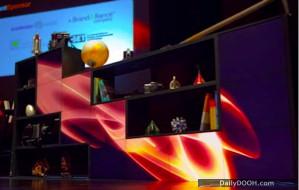Readers of the DailyDOOH probably don’t need any introduction to the wildly popular TED conferences where speakers present thought-provoking ideas on a wide range of topics related to technology, entertainment and design.
Almost as well known are the independently organized TEDx events, one of which – TEDx Waterloo – took place in Kitchener, Canada on March 3rd.
The stage design for TED events is usually informal and often has a ‘living room’ look.
At TEDx Waterloo, the stage designers used eleven MicroTiles as an integral part of a book case – in Issy-Neale (I-N) notation this is a _7X4_3H4T_2H2T2HT_H2T3HT_HT5H_ which was very clever use of new and old technology.
Also on-stage (on the table, below the TEDx Waterloo logo to the left in the picture below) was an eight-wide MicroTile ‘ribbon’ display highlighting the speaker’s name. I-N notation: 8X1_8T_
The TEDx Waterloo lobby also had a five high MicroTile display used as a Twitter wall.
TEDx events are largely run by volunteers with support from local sponsors; this event was no exception with over 70 volunteers and more than 50 sponsors.
The MicroTiles were loaned by the University of Waterloo’s Canadian Centre of Art and Technology.
Content was created by Quarry Integrated Communications and the innovative bookshelf and ribbon shapes were by Jennifer Janik and Matt Gorbet, the geniuses at Mad Hatter.
The Twitter wall was created by Patrick Dinnen of Media Lab Toronto.
Bottom photo courtesy of Kevin Hansen Photography



March 9th, 2011 at 00:09 @048
I thought it was bad form to mix long and short definitions in a single row term of an I-N formula. If so, the correct I-N formula for the bookcase MicroTile display would be: _7X4_3H4T_2H2T2H1T_1H2T3H1T_1H1T5H_.
I know, I’m a geek. 🙂
March 9th, 2011 at 12:52 @577
Well spotted Joe! Originally it was indeed bad form to mix the long and short definitions in a single row term. However, although we haven’t talked about it publicly, we decided that it was sensible to allow this mixture for a couple of reasons:
1) To stop the problem of users confusing the two and mixing them up in the same term anyway. We think it felt overly pedantic for users trying to make sure they stuck to one or the other. You can now use any combination of letters representing a single tile element, with an optional number in front of it to multiply if necessary.
2) It isn’t actually too difficult to modify the parsing rules to be able to machine read either style of term or a mixture.
Bob was aware of this when he wrote the piece, so wasn’t actually a victim of point 1.
You maybe a geek, but you also have an excellent memory and a good eye for detail!
March 9th, 2011 at 12:59 @582
The good news is that there are at least 3 users of I-N notation: Andrew, Joe and me! Momentum is gathering. 🙂